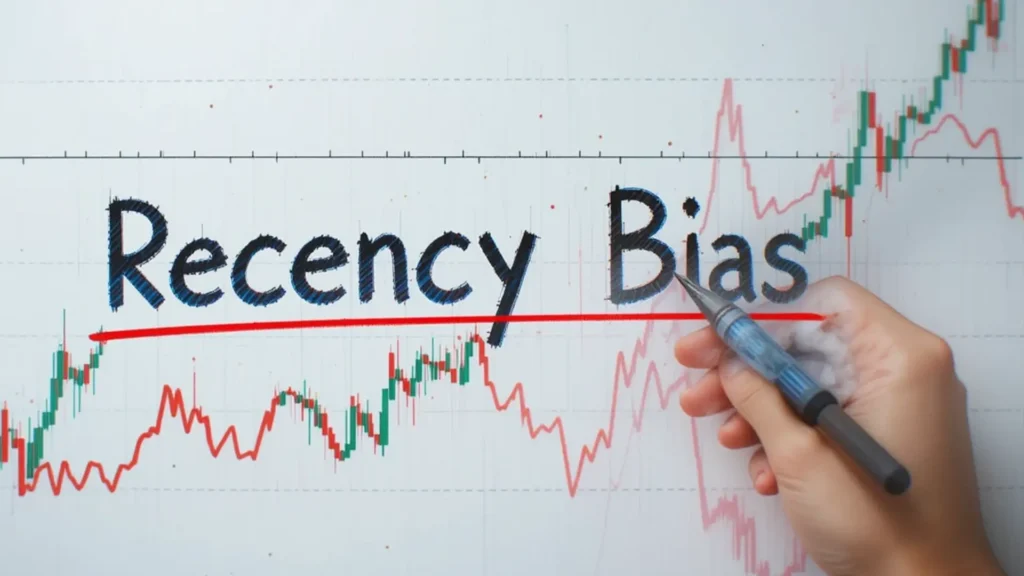You make decisions in the stock market every day. Some are good, some are bad. But what if your brain tricks you into giving more weight to what just happened than what really matters? That is recency bias, and it silently drains your gains.
Recency bias makes you trust the most recent events more than the bigger picture. If a stock goes up this week, you start to think it will keep going up. If it falls, you panic and assume more losses are coming. Neither is true by default, but your brain acts as if it is.
This matters because markets are not short stories. They are long games built on cycles, patterns, and fundamentals. When you let recent price moves control your judgment, you miss the real signals. That means missed profits and bigger losses.
You may believe you are logical, but numbers prove otherwise. Research shows most traders exit too soon when stocks fall and chase too late when stocks rise. Recency bias is at the core of this behavior. If you can see it clearly, you can beat it.
How Recency Bias Shows Up in Trading
Recency bias shows up in simple ways. You see a stock jump for a few days, and you think the trend will last. You see a crash, and you assume the market is broken. The problem is that short-term events are noisy. They do not show the full story.
Let’s break this down layer by layer.
Buying After a Rally
A stock that rises fast feels safe. Your brain tells you it has momentum, and you imagine the gains will keep coming. That feeling is strong because your most recent memory is seeing green charts and rising numbers. Recency bias makes you forget that the price may already be too high.
When you buy after a rally, you risk paying a premium. By the time you jump in, much of the growth is already priced in. The traders who bought early are now selling to take profit, and you become the exit liquidity. That means you enter when risk is highest and reward is lowest.
Think of how many traders rushed into meme stocks during peak hype. The first movers made money, but those who entered late lost big when prices fell back down. This is a classic trap of recency bias: trusting recent movement instead of checking fundamentals.
The smarter way is to ask: “Has the company’s real value improved, or am I just reacting to recent price moves?” If the rise has no strong backing from earnings, new products, or business strength, then it is a rally built on hype. Waiting instead of rushing in protects your capital from inflated entries.
Selling in Panic
A sharp drop hurts. Losses feel heavier than gains, and your brain wants quick relief. This is when recency bias pushes you to sell too soon. You assume today’s drop will continue tomorrow, so you lock in losses to stop the pain.
But markets move in cycles, and many sharp drops are corrections, not crashes. A correction clears excess from the market before it rises again. If you sell during these dips, you remove yourself from the recovery. You do not just lose money; you also lose the chance to regain it.
Think back to March 2020. The market fell hard in a short time due to global panic. Many traders sold everything in fear, believing the fall would never stop. Yet within months, the market recovered and hit record highs. Those who sold in panic missed one of the fastest rebounds in history.
This does not mean you should hold forever. It means you need to separate short-term panic from long-term value. A disciplined investor asks: “Has the company’s future changed, or is this just market noise?” If the fundamentals remain strong, holding through the drop is smarter than selling in fear.
Trusting Headlines Too Much
News grabs your attention. A shocking headline makes you think the market’s future has changed in one moment. Recency bias makes that headline feel larger than it really is. The result: you buy or sell based on one story instead of the bigger picture.
Headlines move markets, but the impact is usually short. A new policy, earnings miss, or scandal may swing a stock for a day or a week. But over months and years, the real driver is business strength, not a single headline. Many traders forget this and overreact.
Take earnings reports as an example. A company may miss estimates and the stock drops fast. Traders rush to sell, assuming it signals long-term weakness. But many companies bounce back in the next quarter. Those who sold on one headline lose out when the price recovers.
Smart investors view headlines as noise unless they change the company’s core story. For example, if a news event shows fraud, bankruptcy risk, or a broken business model, then yes—it matters. But if it is just short-term drama, the best move is to stay calm and focus on fundamentals.
Forgetting the Past Cycles
Markets are not straight lines. They rise, fall, pause, and repeat. Recency bias makes you fixate on what just happened. If the market is climbing, you assume it will never stop. If it is falling, you assume it will never recover. Both assumptions are false.
History shows repeated cycles of growth and decline. Bulls follow bears, and corrections follow rallies. Traders who ignore past patterns treat today’s move as permanent. They forget that downturns are followed by rebounds, and strong rallies are followed by pauses.
For example, after the 2008 financial crisis, markets dropped dramatically. Panic was everywhere. Traders who believed the fall would continue sold aggressively. Those who remembered past recoveries and held on saw substantial gains over the following years. The lesson is simple: cycles always turn.
The danger comes from trusting your recent memory more than long-term history. Your brain gives more weight to the last few days or weeks than the larger trends that actually govern markets. This is why many traders chase highs and sell lows. The market punishes this repeatedly.
To beat this, always look at long-term charts. Monthly or yearly charts show trends clearly. Historical patterns remind you that no move is permanent. Understanding cycles breaks the grip of recency bias and protects your money from reactive mistakes.
How to Beat Recency Bias and Trade Smarter
Now the question: how do you fight recency bias? The answer is discipline and clear systems. Let’s go step by step.
Keep Long-Term Charts
Short-term charts show every tiny price move. They make spikes and drops feel larger than they are. Your brain reacts to these quick changes, creating fear or excitement. That is recency bias at work.
Weekly or monthly charts show the bigger picture. They reveal trends, cycles, and long-term growth. When you see the larger trend, short-term noise matters less. You can make decisions based on real patterns, not temporary swings.
For instance, a stock may fall 5% in a day. On a daily chart, it looks huge. On a monthly chart, it is just a small blip in a strong uptrend. Long-term charts force you to act logically, reducing impulsive trades caused by recent moves.
Use Written Rules
Writing down rules before you trade is powerful. You decide in advance when to buy, when to sell, and how much to risk. For example: “I will buy only if earnings grow for three consecutive quarters,” or “I will sell if losses exceed 5%.”
When rules are written, your decisions rely on logic, not emotion. During volatile days, your brain wants to react to the latest news or price move. Written rules act as a checkpoint, forcing you to pause and follow your strategy.
Traders who rely on instinct often fall into the recency bias trap. Those who follow written rules avoid chasing spikes or selling in panic. Rules turn unpredictable emotions into predictable, disciplined actions.
Track Past Mistakes
A trading journal is a mirror for your decisions. Record why you entered a trade, why you exited, and what actually happened. Include whether recent price moves or news influenced your choice.
Review your journal monthly. You will notice patterns: many bad trades happen after recent spikes or drops. Seeing this clearly helps you separate emotion from strategy.
Tracking mistakes also builds self-awareness. Once you recognize how recency bias affects you, you can plan better trades. Awareness alone reduces impulsive decisions and strengthens your control over future trades.
Separate Noise from Signal
Not every market move is important. Headlines, social media hype, or a sudden spike in stock price may look meaningful, but most of the time they are just noise. Acting on noise leads to mistakes and losses.
Ask yourself: “Does this event change the company’s core value?” If the answer is no, it is noise. For example, a product recall may scare investors for a week, but if the company has strong management and healthy finances, the long-term story remains intact.
Train yourself to focus only on signals that matter—changes in earnings, revenue growth, management decisions, or competitive position. By filtering out noise, you prevent impulsive trades driven by the latest memory, and you base decisions on facts, not emotion.
Use Risk Management Always
Recency bias makes you want to bet heavily on hot trades. A stock has soared recently, and your brain says, “Put more money in.” This can destroy your account if the market reverses.
Set strict risk limits before you trade. Never risk more than a fixed percentage of your capital on a single trade. This protects your account from large losses and keeps you in the game long enough to profit from real trends.
Risk management also reduces emotional pressure. When you know the maximum you can lose, short-term fluctuations feel smaller. You can hold through corrections and avoid panic selling, which is exactly what recency bias tries to push you into.
These methods are simple, but they work because they break the link between fresh memory and impulsive action. Once you do this, your decisions shift from emotional to strategic.
Recency bias will never vanish. It is part of human wiring. But awareness is power. Once you see it, you can step back and act with control.
Traders who ignore it repeat the same mistakes—chasing rallies, panicking in drops, trusting short-term news. Traders who master it gain an edge. They see beyond the noise. They build wealth through discipline, not impulse.
The next time you feel pressure to act on the latest move, pause. Ask yourself: “Am I acting on a long-term signal, or is my brain stuck on fresh memory?” That single pause can save you thousands.
The stock market rewards patience and clear thinking. Understanding recency bias is not just about avoiding mistakes. It is about building habits that protect your money and grow your confidence. In the end, the edge belongs to those who think beyond the recent past.




